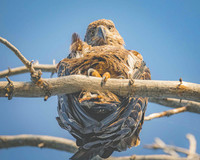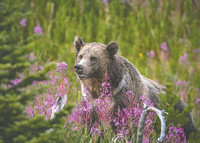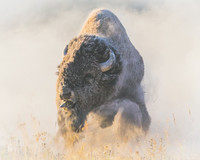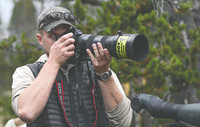Clear, 32° F
Peter Mangolds just might be proof that you can have your cake and eat it, too.
Mangolds works as a ranger at Yellowstone National Park — but once the work day is done, he trades his …
This item is available in full to subscribers.
The Powell Tribune has expanded its online content. To continue reading, you will need to either log in to your subscriber account, or purchase a subscription.
If you are a current print subscriber, you can set up a free web account by clicking here.
If you already have a web account, but need to reset it, you can do so by clicking here.
If you would like to purchase a subscription click here.
Please log in to continue |
|




Peter Mangolds just might be proof that you can have your cake and eat it, too.
Mangolds works as a ranger at Yellowstone National Park — but once the work day is done, he trades his ranger gear for a Canon EOS 5D camera and Sigma 150-600mm zoom lens and begins taking photos of the diverse wildlife that calls the park home.
“I picked up a camera two years ago — my dad actually bought me one for Christmas — and I fell in love with it,” Mangolds said. “I took my first couple of shots, and one of them came out really well that I’ve printed out and put on the wall. Since then, I’ve just been hooked and doing it everywhere I go.”
One of those first shots came when Mangolds was working in the offseason as a dog musher in West Yellowstone, Montana, during the winter of 2016-17. He was out on a run when he came across a group of bison walking down the road, shoulder to shoulder in the snow.
“I didn’t know anything about camera settings [or] how to use it,” Mangolds said. “I just took the camera out and just started firing away — and sure enough, it came out really good.”
While Mangolds enjoys shooting many kinds of wildlife, his favorites are bison, grizzlies and black bears.
“I love the bison and the bears primarily because they are the most expressive of their personalities,” Mangolds said. “You can tell what they’re thinking just by looking at their face sometimes.”
At Yellowstone, Mangolds shoots mainly on the East Entrance Road between Sylvan Lake and Fishing Bridge and in Hayden Valley.
The East Entrance Road area is home to lots of bears, including the mother and daughter grizzly pair known to many Yellowstone park-goers as Raspberry and Snow.
“They’ve been pretty reliable,” Mangolds said of Raspberry and Snow, “but we’ve also had a lot of other wildcards in there, just random bears, because it butts right up against Pelican Valley, which is the most heavily grizzly populated portion of North America — if not the world.”
Mangolds also enjoys heading up to Hayden Valley, which sits next to the Yellowstone River.
“Hayden Valley has always been famous for its wildlife,” Mangolds said. “You just can’t beat it for varieties.”
Mangolds’ favorite times of year to shoot photos are the spring and fall.
“Spring here is amazing for bears,” Mangolds said. As spring heads toward summer, he noted it brings out red dogs (bison calves) and other young wildlife, including bear cubs and elk calves.
Meanwhile, the fall brings bright colors and animals changing into their winter coats as the weather gets cooler.
“The elk are out — they’re bugling [and] they’re getting together,” Mangolds said. “You have bison rut [too].”
However, wildlife photography is not as easy as it looks, even for a park ranger. Mangolds said that a lot of work, including waiting and scouting, goes into getting those outstanding photos.
“The waiting game can be pretty intense,” Mangolds said. “Sometimes, you can wait 10-12 hours and nothing shows up [or] you’ll be sitting there for 10 hours and finally a bear shows up — and then a whole crowd of people do. It can be frustrating because they just swarm around right in front of you.”
There is also the danger of an animal getting too close for comfort.
“You always have to keep your head on a swivel because, especially with bison, they’re always moving around,” Mangolds said. “For such a large animal, they can be very quiet. ... There is the danger of being too tunnel-visioned on [photographing] an animal or something, and all of a sudden you hear a grunt behind you and right across the street there’s a bunch of bison — and they’re coming right toward you.”
Mangolds has become one of northwest Wyoming’s better-known wildlife photographers, thanks in part to posting his photos on Facebook and Instagram. On the latter, Mangolds is known as “grizzlymanchild,” where he has 2,500 followers.
“I’ve made a lot of connections and a lot of friendships through it,” Mangolds said. “You spend a lot of time at these animal jams doing the waiting game and you get to know people, because you’re all sitting there waiting for the same reason. But it’s really cool being able to connect with people from different backgrounds. We’re all here for the same thing: To watch wildlife in its prime and to see something cool in Yellowstone.”
Mangolds grew up in Massachusetts and got his forestry degree from Paul Smith’s College in upstate New York. After working for a few years in New York and other places, he was set to work in the Hiawatha National Forest in Minnesota in 2016. Then his plans changed.
“I was set and ready to go with them and then all of a sudden, I got a phone call from Wyoming in late March, I believe, which is really, really late for the season hiring,” Mangolds said. “Usually they like to do it four to six months ahead of time.”
The call was from Yellowstone National Park, and the woman on the phone informed him that a position had become open and asked if he was interested.
“I’m thinking to myself, ‘Is this lady for real?’,” Mangolds said. “[I said] ‘I’m definitely still interested and I could become available.’”
While Mangolds asked for a day to think about the job offer, his mind was made up and he accepted the job the next day. He started working at the park in June 2016.
At Yellowstone, Mangolds works for resource management and deals with invasive plant control and hazard tree removal, but he also is involved some with wildlife management, such as crowd control at bear and bison jams.
However, being a ranger and a photographer can bring a few challenges, including extra scrutiny.
“Being a photographer and a ranger obviously brings a lot of spotlights and microscopes on me, especially because I share all my pictures with the world on Facebook and Instagram ...,” Mangolds said. “Being both a ranger and photographer, there have been certain situations where it’s real tough, because when people start getting too close to a bear, all of the people that know you’re a ranger look at you to do something — and you can’t because you’re not on duty.”
However, the positives outweigh any negatives for Mangolds.
“It’s really cool, because I really enjoy sharing what I get to see on a day-to-day basis — the beauty I see in the world,” Mangolds said. “I get to share that with other people who aren’t as fortunate as I am to live in Yellowstone for six months at a time, or to go to these other beautiful places. It’s really cool how people come to me versus me being the person always asking for help.”